Techsearch Case Study: Analyzing Leadership and Change Management
VerifiedAdded on 2023/03/30
|11
|3948
|175
Case Study
AI Summary
This assignment analyzes the Techsearch case study, focusing on Dan Caulfield's attempt to implement a paperless system within his employment agency. The analysis covers Dan's goals, operational plans, and the mistakes he made, including a lack of planning and stakeholder involvement. A SWOT analysis is presented to highlight strengths, weaknesses, opportunities, and threats. The assignment examines the stakeholders involved, including employees, financiers, and shareholders, and explains the reasons for resistance to change. The study also provides suggestions for improving the change process, emphasizing the importance of communication, stakeholder consultation, and incentivization. Multiple-choice questions on related topics like profit and loss statements, resistance to change, and the Deming cycle are also answered. The assignment concludes by discussing the connection between operational and strategic plans and the purpose of a mission statement and SWOT analysis in business improvement.
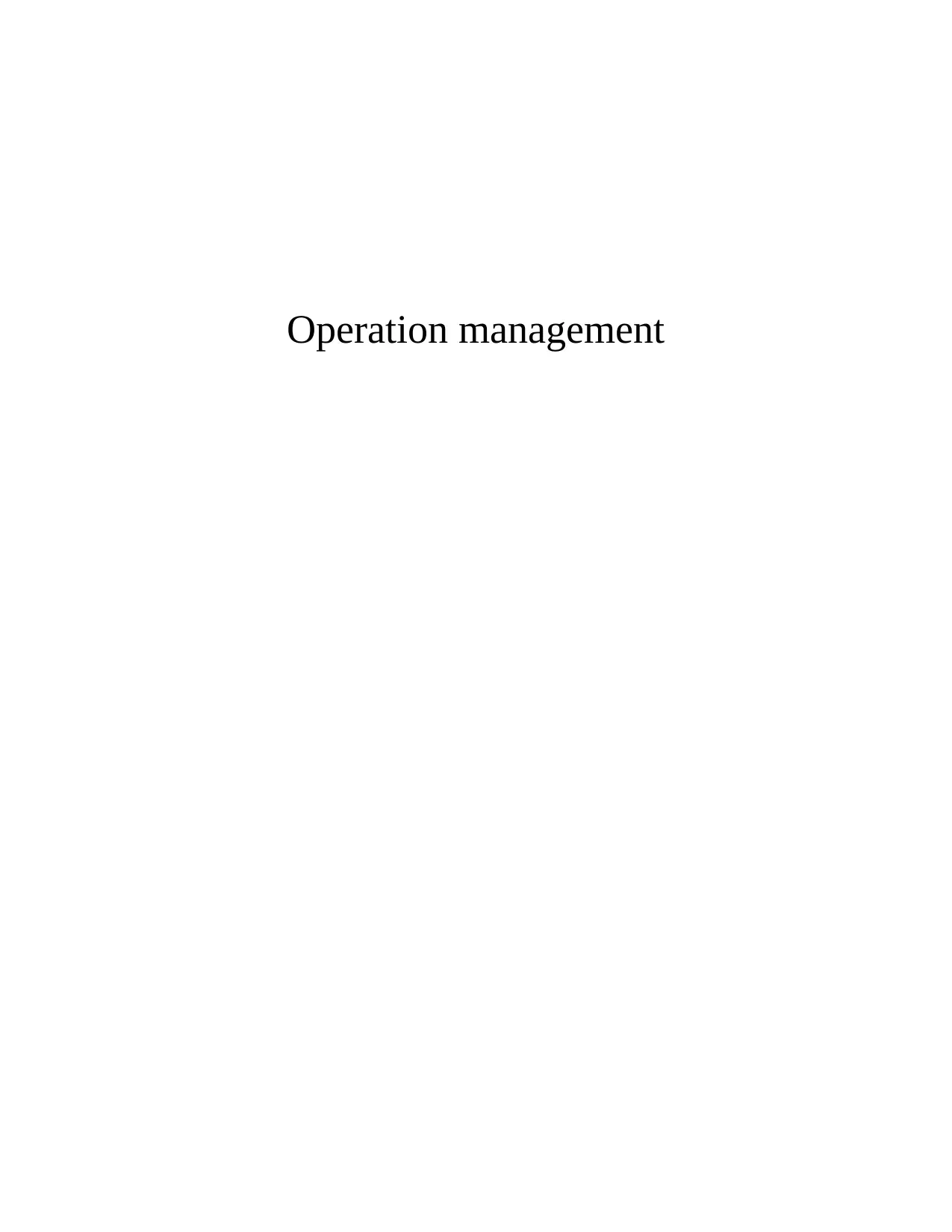
Operation management
Paraphrase This Document
Need a fresh take? Get an instant paraphrase of this document with our AI Paraphraser
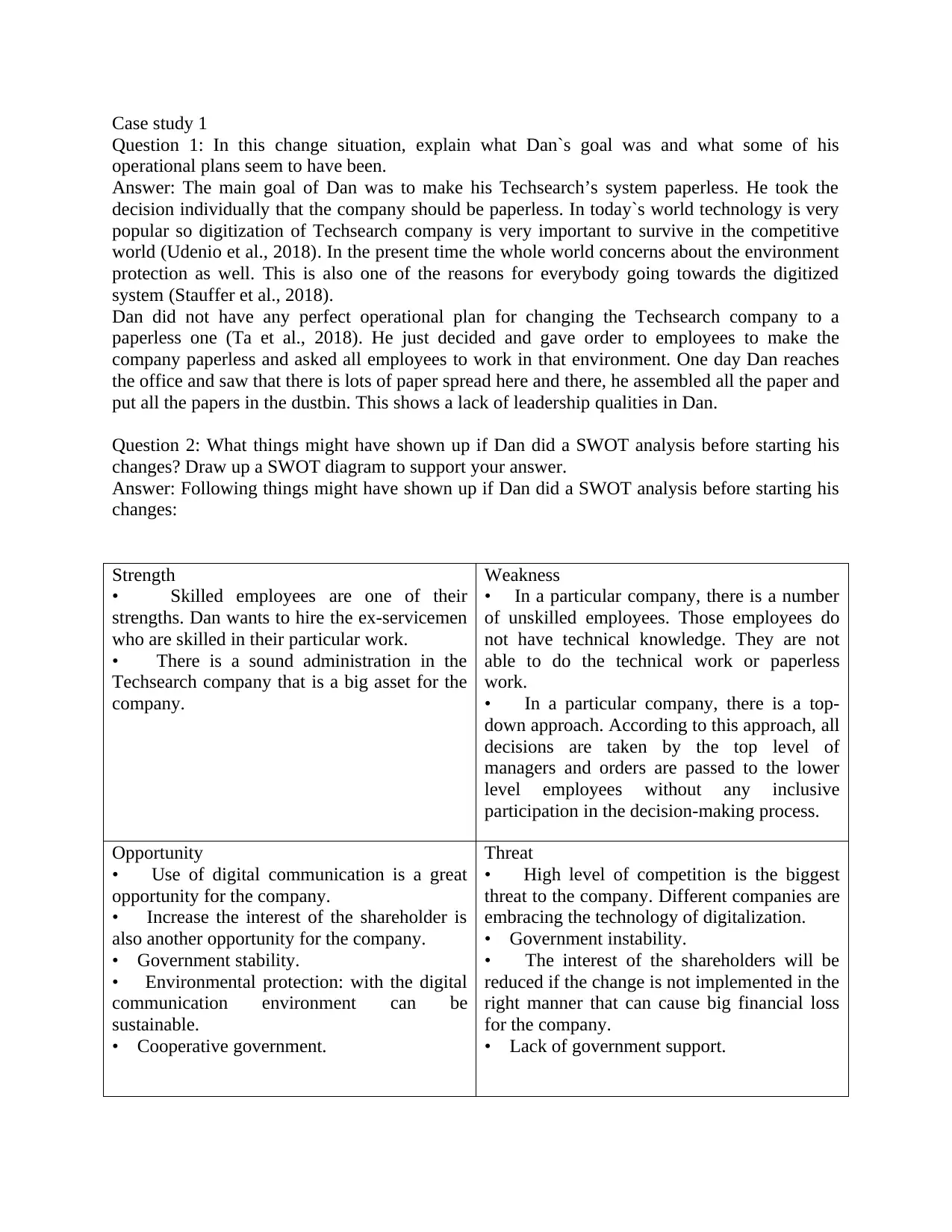
Case study 1
Question 1: In this change situation, explain what Dan`s goal was and what some of his
operational plans seem to have been.
Answer: The main goal of Dan was to make his Techsearch’s system paperless. He took the
decision individually that the company should be paperless. In today`s world technology is very
popular so digitization of Techsearch company is very important to survive in the competitive
world (Udenio et al., 2018). In the present time the whole world concerns about the environment
protection as well. This is also one of the reasons for everybody going towards the digitized
system (Stauffer et al., 2018).
Dan did not have any perfect operational plan for changing the Techsearch company to a
paperless one (Ta et al., 2018). He just decided and gave order to employees to make the
company paperless and asked all employees to work in that environment. One day Dan reaches
the office and saw that there is lots of paper spread here and there, he assembled all the paper and
put all the papers in the dustbin. This shows a lack of leadership qualities in Dan.
Question 2: What things might have shown up if Dan did a SWOT analysis before starting his
changes? Draw up a SWOT diagram to support your answer.
Answer: Following things might have shown up if Dan did a SWOT analysis before starting his
changes:
Strength
• Skilled employees are one of their
strengths. Dan wants to hire the ex-servicemen
who are skilled in their particular work.
• There is a sound administration in the
Techsearch company that is a big asset for the
company.
Weakness
• In a particular company, there is a number
of unskilled employees. Those employees do
not have technical knowledge. They are not
able to do the technical work or paperless
work.
• In a particular company, there is a top-
down approach. According to this approach, all
decisions are taken by the top level of
managers and orders are passed to the lower
level employees without any inclusive
participation in the decision-making process.
Opportunity
• Use of digital communication is a great
opportunity for the company.
• Increase the interest of the shareholder is
also another opportunity for the company.
• Government stability.
• Environmental protection: with the digital
communication environment can be
sustainable.
• Cooperative government.
Threat
• High level of competition is the biggest
threat to the company. Different companies are
embracing the technology of digitalization.
• Government instability.
• The interest of the shareholders will be
reduced if the change is not implemented in the
right manner that can cause big financial loss
for the company.
• Lack of government support.
Question 1: In this change situation, explain what Dan`s goal was and what some of his
operational plans seem to have been.
Answer: The main goal of Dan was to make his Techsearch’s system paperless. He took the
decision individually that the company should be paperless. In today`s world technology is very
popular so digitization of Techsearch company is very important to survive in the competitive
world (Udenio et al., 2018). In the present time the whole world concerns about the environment
protection as well. This is also one of the reasons for everybody going towards the digitized
system (Stauffer et al., 2018).
Dan did not have any perfect operational plan for changing the Techsearch company to a
paperless one (Ta et al., 2018). He just decided and gave order to employees to make the
company paperless and asked all employees to work in that environment. One day Dan reaches
the office and saw that there is lots of paper spread here and there, he assembled all the paper and
put all the papers in the dustbin. This shows a lack of leadership qualities in Dan.
Question 2: What things might have shown up if Dan did a SWOT analysis before starting his
changes? Draw up a SWOT diagram to support your answer.
Answer: Following things might have shown up if Dan did a SWOT analysis before starting his
changes:
Strength
• Skilled employees are one of their
strengths. Dan wants to hire the ex-servicemen
who are skilled in their particular work.
• There is a sound administration in the
Techsearch company that is a big asset for the
company.
Weakness
• In a particular company, there is a number
of unskilled employees. Those employees do
not have technical knowledge. They are not
able to do the technical work or paperless
work.
• In a particular company, there is a top-
down approach. According to this approach, all
decisions are taken by the top level of
managers and orders are passed to the lower
level employees without any inclusive
participation in the decision-making process.
Opportunity
• Use of digital communication is a great
opportunity for the company.
• Increase the interest of the shareholder is
also another opportunity for the company.
• Government stability.
• Environmental protection: with the digital
communication environment can be
sustainable.
• Cooperative government.
Threat
• High level of competition is the biggest
threat to the company. Different companies are
embracing the technology of digitalization.
• Government instability.
• The interest of the shareholders will be
reduced if the change is not implemented in the
right manner that can cause big financial loss
for the company.
• Lack of government support.
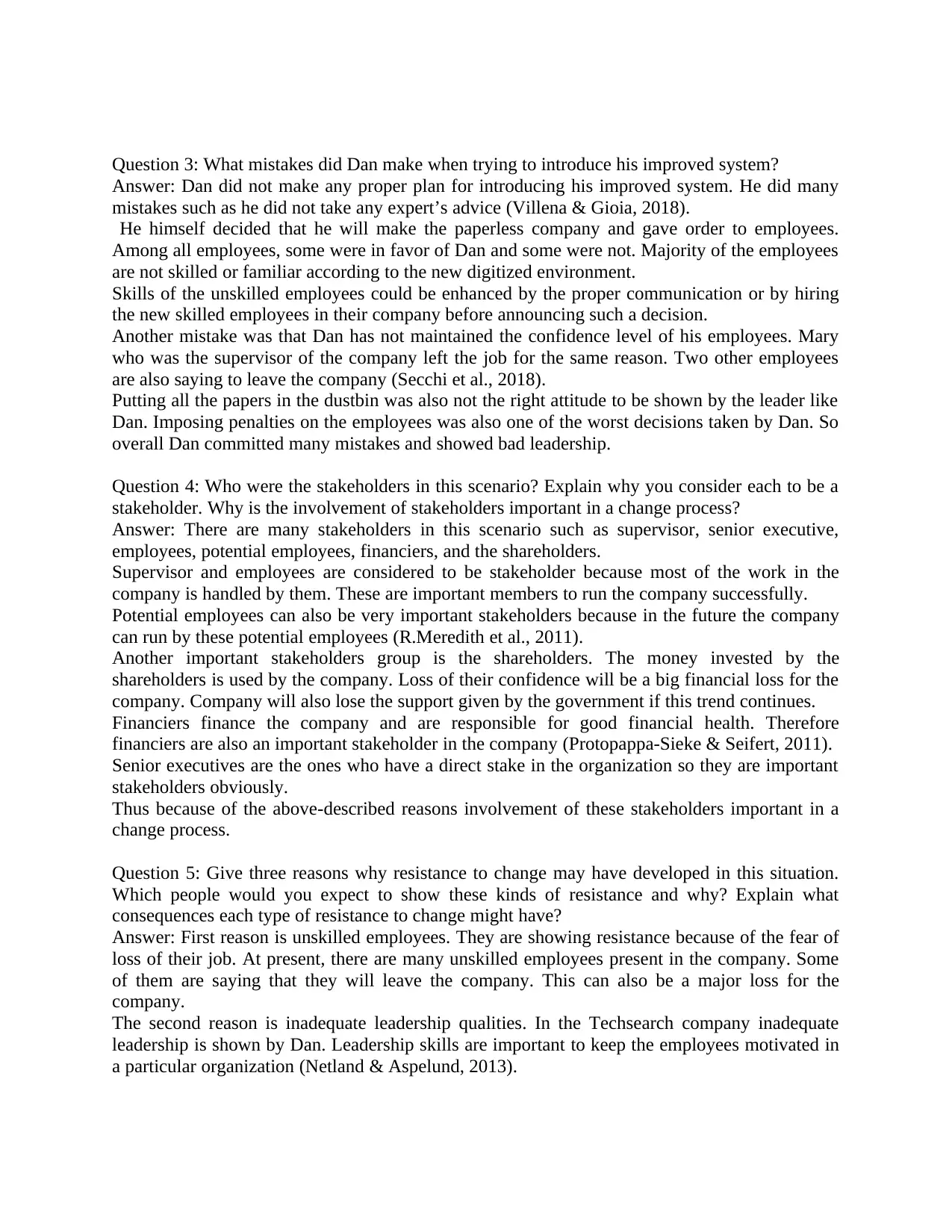
Question 3: What mistakes did Dan make when trying to introduce his improved system?
Answer: Dan did not make any proper plan for introducing his improved system. He did many
mistakes such as he did not take any expert’s advice (Villena & Gioia, 2018).
He himself decided that he will make the paperless company and gave order to employees.
Among all employees, some were in favor of Dan and some were not. Majority of the employees
are not skilled or familiar according to the new digitized environment.
Skills of the unskilled employees could be enhanced by the proper communication or by hiring
the new skilled employees in their company before announcing such a decision.
Another mistake was that Dan has not maintained the confidence level of his employees. Mary
who was the supervisor of the company left the job for the same reason. Two other employees
are also saying to leave the company (Secchi et al., 2018).
Putting all the papers in the dustbin was also not the right attitude to be shown by the leader like
Dan. Imposing penalties on the employees was also one of the worst decisions taken by Dan. So
overall Dan committed many mistakes and showed bad leadership.
Question 4: Who were the stakeholders in this scenario? Explain why you consider each to be a
stakeholder. Why is the involvement of stakeholders important in a change process?
Answer: There are many stakeholders in this scenario such as supervisor, senior executive,
employees, potential employees, financiers, and the shareholders.
Supervisor and employees are considered to be stakeholder because most of the work in the
company is handled by them. These are important members to run the company successfully.
Potential employees can also be very important stakeholders because in the future the company
can run by these potential employees (R.Meredith et al., 2011).
Another important stakeholders group is the shareholders. The money invested by the
shareholders is used by the company. Loss of their confidence will be a big financial loss for the
company. Company will also lose the support given by the government if this trend continues.
Financiers finance the company and are responsible for good financial health. Therefore
financiers are also an important stakeholder in the company (Protopappa-Sieke & Seifert, 2011).
Senior executives are the ones who have a direct stake in the organization so they are important
stakeholders obviously.
Thus because of the above-described reasons involvement of these stakeholders important in a
change process.
Question 5: Give three reasons why resistance to change may have developed in this situation.
Which people would you expect to show these kinds of resistance and why? Explain what
consequences each type of resistance to change might have?
Answer: First reason is unskilled employees. They are showing resistance because of the fear of
loss of their job. At present, there are many unskilled employees present in the company. Some
of them are saying that they will leave the company. This can also be a major loss for the
company.
The second reason is inadequate leadership qualities. In the Techsearch company inadequate
leadership is shown by Dan. Leadership skills are important to keep the employees motivated in
a particular organization (Netland & Aspelund, 2013).
Answer: Dan did not make any proper plan for introducing his improved system. He did many
mistakes such as he did not take any expert’s advice (Villena & Gioia, 2018).
He himself decided that he will make the paperless company and gave order to employees.
Among all employees, some were in favor of Dan and some were not. Majority of the employees
are not skilled or familiar according to the new digitized environment.
Skills of the unskilled employees could be enhanced by the proper communication or by hiring
the new skilled employees in their company before announcing such a decision.
Another mistake was that Dan has not maintained the confidence level of his employees. Mary
who was the supervisor of the company left the job for the same reason. Two other employees
are also saying to leave the company (Secchi et al., 2018).
Putting all the papers in the dustbin was also not the right attitude to be shown by the leader like
Dan. Imposing penalties on the employees was also one of the worst decisions taken by Dan. So
overall Dan committed many mistakes and showed bad leadership.
Question 4: Who were the stakeholders in this scenario? Explain why you consider each to be a
stakeholder. Why is the involvement of stakeholders important in a change process?
Answer: There are many stakeholders in this scenario such as supervisor, senior executive,
employees, potential employees, financiers, and the shareholders.
Supervisor and employees are considered to be stakeholder because most of the work in the
company is handled by them. These are important members to run the company successfully.
Potential employees can also be very important stakeholders because in the future the company
can run by these potential employees (R.Meredith et al., 2011).
Another important stakeholders group is the shareholders. The money invested by the
shareholders is used by the company. Loss of their confidence will be a big financial loss for the
company. Company will also lose the support given by the government if this trend continues.
Financiers finance the company and are responsible for good financial health. Therefore
financiers are also an important stakeholder in the company (Protopappa-Sieke & Seifert, 2011).
Senior executives are the ones who have a direct stake in the organization so they are important
stakeholders obviously.
Thus because of the above-described reasons involvement of these stakeholders important in a
change process.
Question 5: Give three reasons why resistance to change may have developed in this situation.
Which people would you expect to show these kinds of resistance and why? Explain what
consequences each type of resistance to change might have?
Answer: First reason is unskilled employees. They are showing resistance because of the fear of
loss of their job. At present, there are many unskilled employees present in the company. Some
of them are saying that they will leave the company. This can also be a major loss for the
company.
The second reason is inadequate leadership qualities. In the Techsearch company inadequate
leadership is shown by Dan. Leadership skills are important to keep the employees motivated in
a particular organization (Netland & Aspelund, 2013).
⊘ This is a preview!⊘
Do you want full access?
Subscribe today to unlock all pages.

Trusted by 1+ million students worldwide
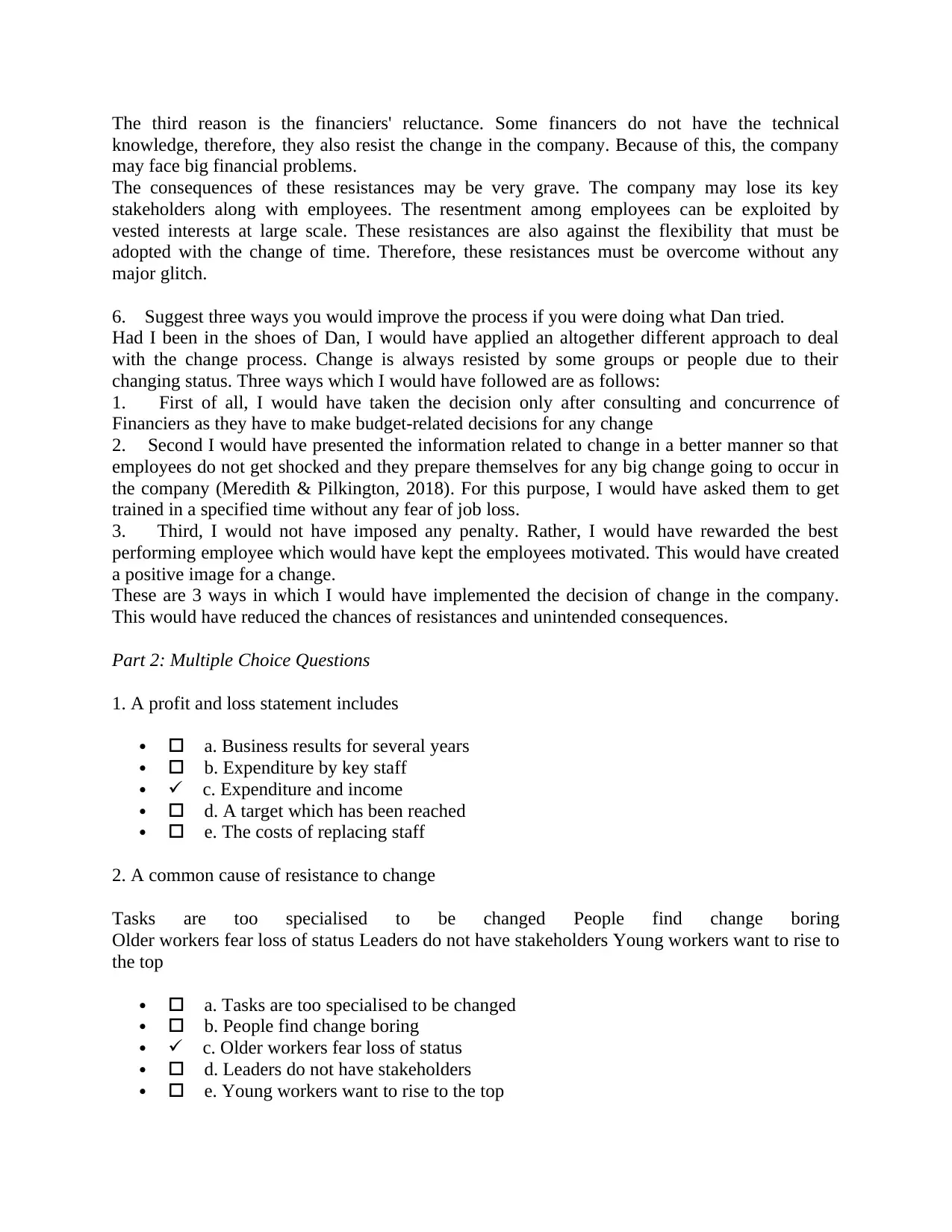
The third reason is the financiers' reluctance. Some financers do not have the technical
knowledge, therefore, they also resist the change in the company. Because of this, the company
may face big financial problems.
The consequences of these resistances may be very grave. The company may lose its key
stakeholders along with employees. The resentment among employees can be exploited by
vested interests at large scale. These resistances are also against the flexibility that must be
adopted with the change of time. Therefore, these resistances must be overcome without any
major glitch.
6. Suggest three ways you would improve the process if you were doing what Dan tried.
Had I been in the shoes of Dan, I would have applied an altogether different approach to deal
with the change process. Change is always resisted by some groups or people due to their
changing status. Three ways which I would have followed are as follows:
1. First of all, I would have taken the decision only after consulting and concurrence of
Financiers as they have to make budget-related decisions for any change
2. Second I would have presented the information related to change in a better manner so that
employees do not get shocked and they prepare themselves for any big change going to occur in
the company (Meredith & Pilkington, 2018). For this purpose, I would have asked them to get
trained in a specified time without any fear of job loss.
3. Third, I would not have imposed any penalty. Rather, I would have rewarded the best
performing employee which would have kept the employees motivated. This would have created
a positive image for a change.
These are 3 ways in which I would have implemented the decision of change in the company.
This would have reduced the chances of resistances and unintended consequences.
Part 2: Multiple Choice Questions
1. A profit and loss statement includes
a. Business results for several years
b. Expenditure by key staff
c. Expenditure and income
d. A target which has been reached
e. The costs of replacing staff
2. A common cause of resistance to change
Tasks are too specialised to be changed People find change boring
Older workers fear loss of status Leaders do not have stakeholders Young workers want to rise to
the top
a. Tasks are too specialised to be changed
b. People find change boring
c. Older workers fear loss of status
d. Leaders do not have stakeholders
e. Young workers want to rise to the top
knowledge, therefore, they also resist the change in the company. Because of this, the company
may face big financial problems.
The consequences of these resistances may be very grave. The company may lose its key
stakeholders along with employees. The resentment among employees can be exploited by
vested interests at large scale. These resistances are also against the flexibility that must be
adopted with the change of time. Therefore, these resistances must be overcome without any
major glitch.
6. Suggest three ways you would improve the process if you were doing what Dan tried.
Had I been in the shoes of Dan, I would have applied an altogether different approach to deal
with the change process. Change is always resisted by some groups or people due to their
changing status. Three ways which I would have followed are as follows:
1. First of all, I would have taken the decision only after consulting and concurrence of
Financiers as they have to make budget-related decisions for any change
2. Second I would have presented the information related to change in a better manner so that
employees do not get shocked and they prepare themselves for any big change going to occur in
the company (Meredith & Pilkington, 2018). For this purpose, I would have asked them to get
trained in a specified time without any fear of job loss.
3. Third, I would not have imposed any penalty. Rather, I would have rewarded the best
performing employee which would have kept the employees motivated. This would have created
a positive image for a change.
These are 3 ways in which I would have implemented the decision of change in the company.
This would have reduced the chances of resistances and unintended consequences.
Part 2: Multiple Choice Questions
1. A profit and loss statement includes
a. Business results for several years
b. Expenditure by key staff
c. Expenditure and income
d. A target which has been reached
e. The costs of replacing staff
2. A common cause of resistance to change
Tasks are too specialised to be changed People find change boring
Older workers fear loss of status Leaders do not have stakeholders Young workers want to rise to
the top
a. Tasks are too specialised to be changed
b. People find change boring
c. Older workers fear loss of status
d. Leaders do not have stakeholders
e. Young workers want to rise to the top
Paraphrase This Document
Need a fresh take? Get an instant paraphrase of this document with our AI Paraphraser
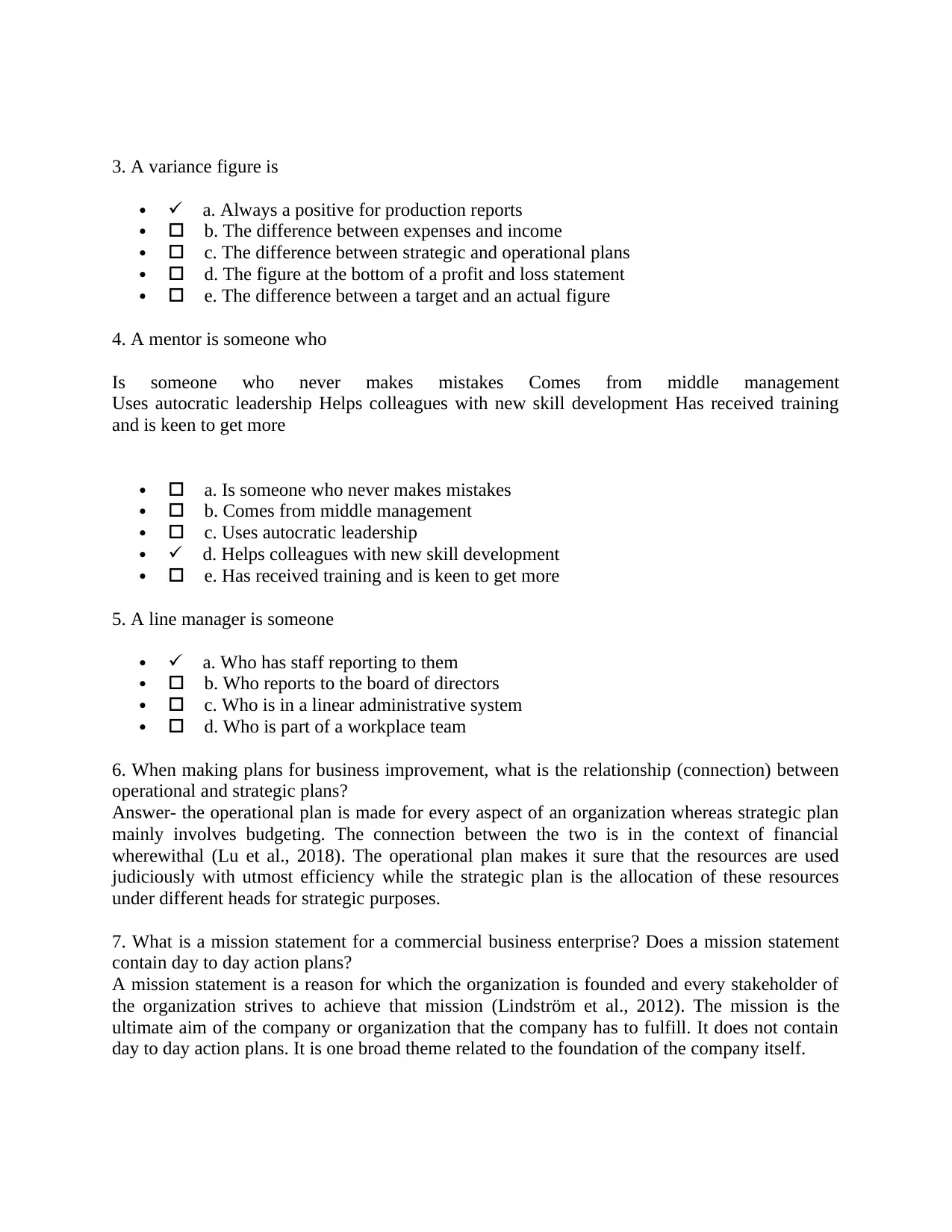
3. A variance figure is
a. Always a positive for production reports
b. The difference between expenses and income
c. The difference between strategic and operational plans
d. The figure at the bottom of a profit and loss statement
e. The difference between a target and an actual figure
4. A mentor is someone who
Is someone who never makes mistakes Comes from middle management
Uses autocratic leadership Helps colleagues with new skill development Has received training
and is keen to get more
a. Is someone who never makes mistakes
b. Comes from middle management
c. Uses autocratic leadership
d. Helps colleagues with new skill development
e. Has received training and is keen to get more
5. A line manager is someone
a. Who has staff reporting to them
b. Who reports to the board of directors
c. Who is in a linear administrative system
d. Who is part of a workplace team
6. When making plans for business improvement, what is the relationship (connection) between
operational and strategic plans?
Answer- the operational plan is made for every aspect of an organization whereas strategic plan
mainly involves budgeting. The connection between the two is in the context of financial
wherewithal (Lu et al., 2018). The operational plan makes it sure that the resources are used
judiciously with utmost efficiency while the strategic plan is the allocation of these resources
under different heads for strategic purposes.
7. What is a mission statement for a commercial business enterprise? Does a mission statement
contain day to day action plans?
A mission statement is a reason for which the organization is founded and every stakeholder of
the organization strives to achieve that mission (Lindström et al., 2012). The mission is the
ultimate aim of the company or organization that the company has to fulfill. It does not contain
day to day action plans. It is one broad theme related to the foundation of the company itself.
a. Always a positive for production reports
b. The difference between expenses and income
c. The difference between strategic and operational plans
d. The figure at the bottom of a profit and loss statement
e. The difference between a target and an actual figure
4. A mentor is someone who
Is someone who never makes mistakes Comes from middle management
Uses autocratic leadership Helps colleagues with new skill development Has received training
and is keen to get more
a. Is someone who never makes mistakes
b. Comes from middle management
c. Uses autocratic leadership
d. Helps colleagues with new skill development
e. Has received training and is keen to get more
5. A line manager is someone
a. Who has staff reporting to them
b. Who reports to the board of directors
c. Who is in a linear administrative system
d. Who is part of a workplace team
6. When making plans for business improvement, what is the relationship (connection) between
operational and strategic plans?
Answer- the operational plan is made for every aspect of an organization whereas strategic plan
mainly involves budgeting. The connection between the two is in the context of financial
wherewithal (Lu et al., 2018). The operational plan makes it sure that the resources are used
judiciously with utmost efficiency while the strategic plan is the allocation of these resources
under different heads for strategic purposes.
7. What is a mission statement for a commercial business enterprise? Does a mission statement
contain day to day action plans?
A mission statement is a reason for which the organization is founded and every stakeholder of
the organization strives to achieve that mission (Lindström et al., 2012). The mission is the
ultimate aim of the company or organization that the company has to fulfill. It does not contain
day to day action plans. It is one broad theme related to the foundation of the company itself.
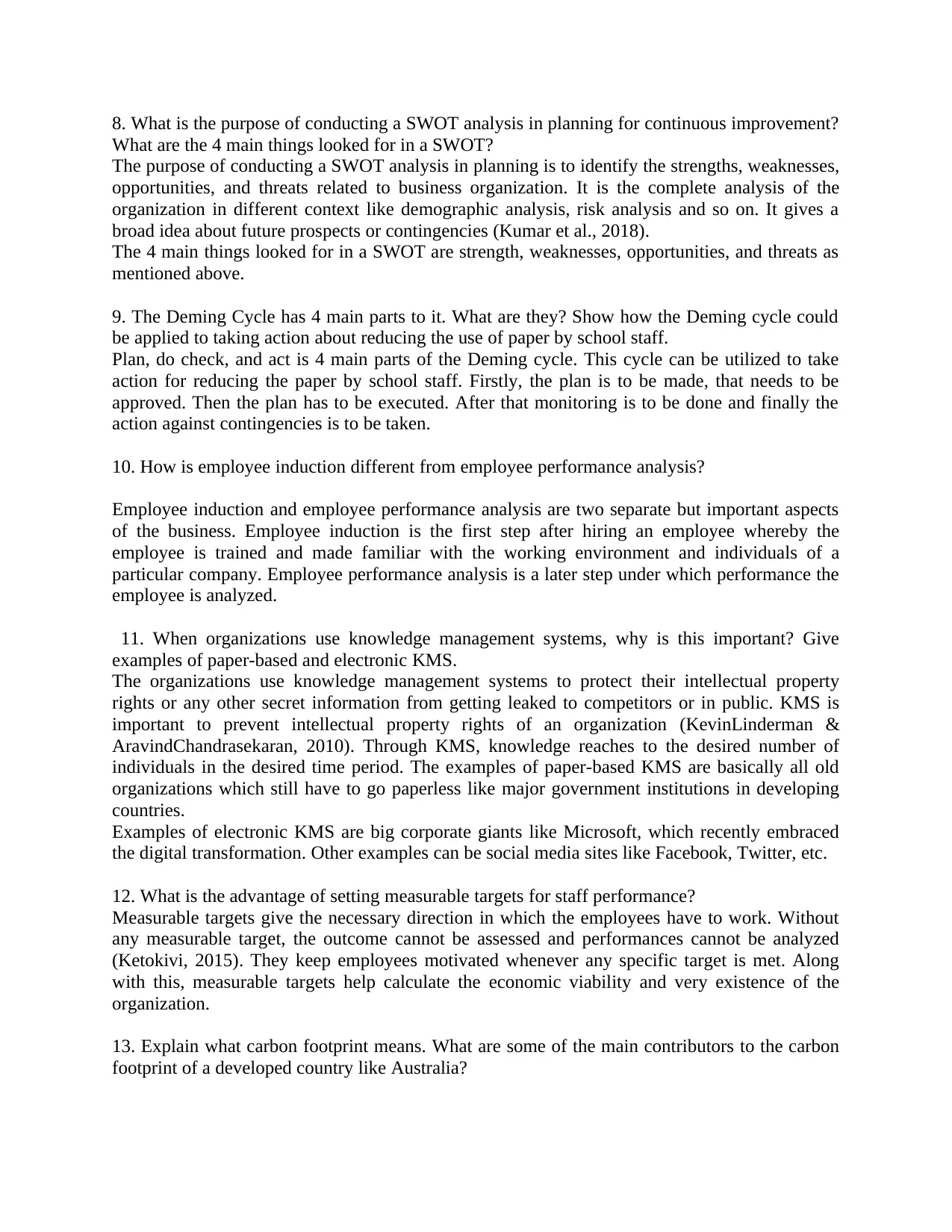
8. What is the purpose of conducting a SWOT analysis in planning for continuous improvement?
What are the 4 main things looked for in a SWOT?
The purpose of conducting a SWOT analysis in planning is to identify the strengths, weaknesses,
opportunities, and threats related to business organization. It is the complete analysis of the
organization in different context like demographic analysis, risk analysis and so on. It gives a
broad idea about future prospects or contingencies (Kumar et al., 2018).
The 4 main things looked for in a SWOT are strength, weaknesses, opportunities, and threats as
mentioned above.
9. The Deming Cycle has 4 main parts to it. What are they? Show how the Deming cycle could
be applied to taking action about reducing the use of paper by school staff.
Plan, do check, and act is 4 main parts of the Deming cycle. This cycle can be utilized to take
action for reducing the paper by school staff. Firstly, the plan is to be made, that needs to be
approved. Then the plan has to be executed. After that monitoring is to be done and finally the
action against contingencies is to be taken.
10. How is employee induction different from employee performance analysis?
Employee induction and employee performance analysis are two separate but important aspects
of the business. Employee induction is the first step after hiring an employee whereby the
employee is trained and made familiar with the working environment and individuals of a
particular company. Employee performance analysis is a later step under which performance the
employee is analyzed.
11. When organizations use knowledge management systems, why is this important? Give
examples of paper-based and electronic KMS.
The organizations use knowledge management systems to protect their intellectual property
rights or any other secret information from getting leaked to competitors or in public. KMS is
important to prevent intellectual property rights of an organization (KevinLinderman &
AravindChandrasekaran, 2010). Through KMS, knowledge reaches to the desired number of
individuals in the desired time period. The examples of paper-based KMS are basically all old
organizations which still have to go paperless like major government institutions in developing
countries.
Examples of electronic KMS are big corporate giants like Microsoft, which recently embraced
the digital transformation. Other examples can be social media sites like Facebook, Twitter, etc.
12. What is the advantage of setting measurable targets for staff performance?
Measurable targets give the necessary direction in which the employees have to work. Without
any measurable target, the outcome cannot be assessed and performances cannot be analyzed
(Ketokivi, 2015). They keep employees motivated whenever any specific target is met. Along
with this, measurable targets help calculate the economic viability and very existence of the
organization.
13. Explain what carbon footprint means. What are some of the main contributors to the carbon
footprint of a developed country like Australia?
What are the 4 main things looked for in a SWOT?
The purpose of conducting a SWOT analysis in planning is to identify the strengths, weaknesses,
opportunities, and threats related to business organization. It is the complete analysis of the
organization in different context like demographic analysis, risk analysis and so on. It gives a
broad idea about future prospects or contingencies (Kumar et al., 2018).
The 4 main things looked for in a SWOT are strength, weaknesses, opportunities, and threats as
mentioned above.
9. The Deming Cycle has 4 main parts to it. What are they? Show how the Deming cycle could
be applied to taking action about reducing the use of paper by school staff.
Plan, do check, and act is 4 main parts of the Deming cycle. This cycle can be utilized to take
action for reducing the paper by school staff. Firstly, the plan is to be made, that needs to be
approved. Then the plan has to be executed. After that monitoring is to be done and finally the
action against contingencies is to be taken.
10. How is employee induction different from employee performance analysis?
Employee induction and employee performance analysis are two separate but important aspects
of the business. Employee induction is the first step after hiring an employee whereby the
employee is trained and made familiar with the working environment and individuals of a
particular company. Employee performance analysis is a later step under which performance the
employee is analyzed.
11. When organizations use knowledge management systems, why is this important? Give
examples of paper-based and electronic KMS.
The organizations use knowledge management systems to protect their intellectual property
rights or any other secret information from getting leaked to competitors or in public. KMS is
important to prevent intellectual property rights of an organization (KevinLinderman &
AravindChandrasekaran, 2010). Through KMS, knowledge reaches to the desired number of
individuals in the desired time period. The examples of paper-based KMS are basically all old
organizations which still have to go paperless like major government institutions in developing
countries.
Examples of electronic KMS are big corporate giants like Microsoft, which recently embraced
the digital transformation. Other examples can be social media sites like Facebook, Twitter, etc.
12. What is the advantage of setting measurable targets for staff performance?
Measurable targets give the necessary direction in which the employees have to work. Without
any measurable target, the outcome cannot be assessed and performances cannot be analyzed
(Ketokivi, 2015). They keep employees motivated whenever any specific target is met. Along
with this, measurable targets help calculate the economic viability and very existence of the
organization.
13. Explain what carbon footprint means. What are some of the main contributors to the carbon
footprint of a developed country like Australia?
⊘ This is a preview!⊘
Do you want full access?
Subscribe today to unlock all pages.

Trusted by 1+ million students worldwide
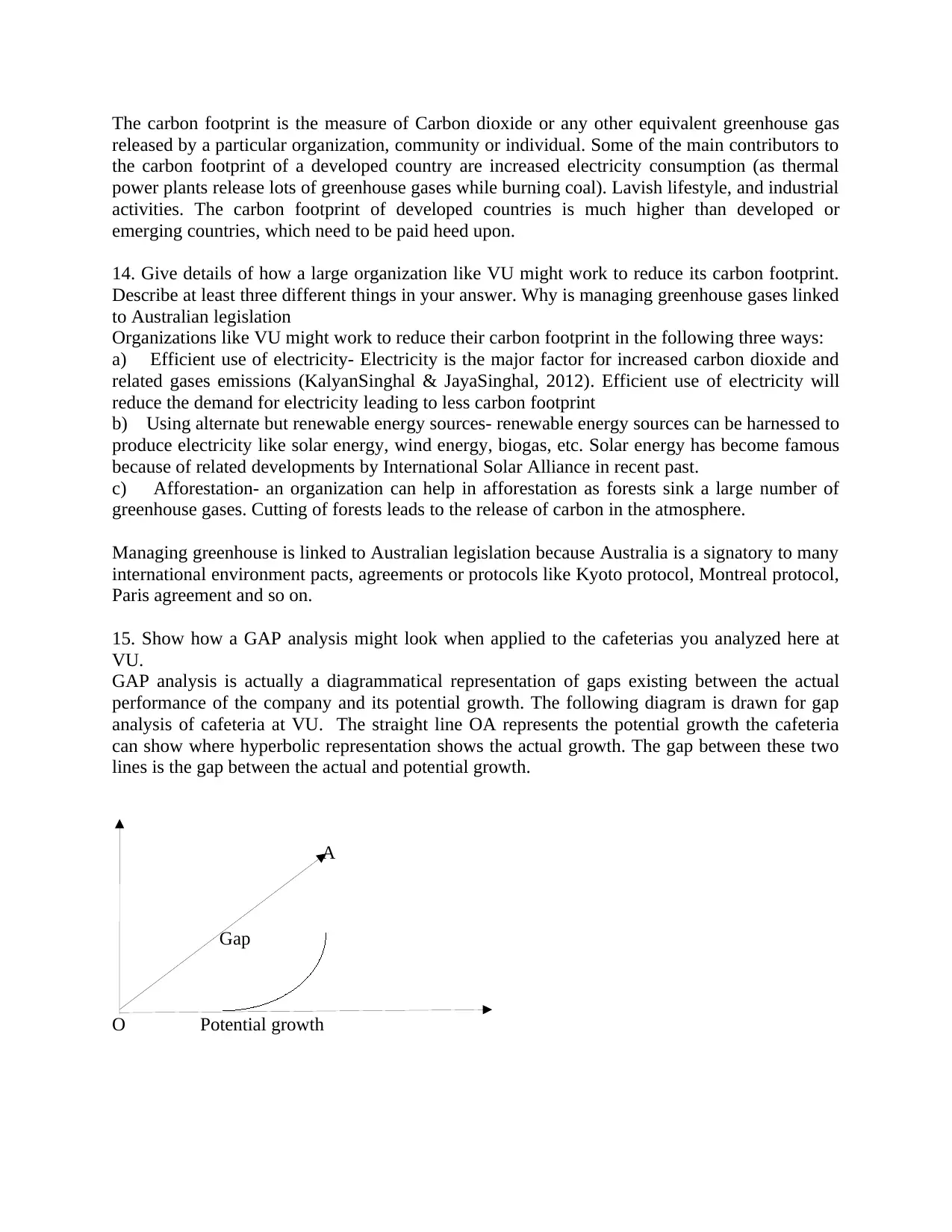
The carbon footprint is the measure of Carbon dioxide or any other equivalent greenhouse gas
released by a particular organization, community or individual. Some of the main contributors to
the carbon footprint of a developed country are increased electricity consumption (as thermal
power plants release lots of greenhouse gases while burning coal). Lavish lifestyle, and industrial
activities. The carbon footprint of developed countries is much higher than developed or
emerging countries, which need to be paid heed upon.
14. Give details of how a large organization like VU might work to reduce its carbon footprint.
Describe at least three different things in your answer. Why is managing greenhouse gases linked
to Australian legislation
Organizations like VU might work to reduce their carbon footprint in the following three ways:
a) Efficient use of electricity- Electricity is the major factor for increased carbon dioxide and
related gases emissions (KalyanSinghal & JayaSinghal, 2012). Efficient use of electricity will
reduce the demand for electricity leading to less carbon footprint
b) Using alternate but renewable energy sources- renewable energy sources can be harnessed to
produce electricity like solar energy, wind energy, biogas, etc. Solar energy has become famous
because of related developments by International Solar Alliance in recent past.
c) Afforestation- an organization can help in afforestation as forests sink a large number of
greenhouse gases. Cutting of forests leads to the release of carbon in the atmosphere.
Managing greenhouse is linked to Australian legislation because Australia is a signatory to many
international environment pacts, agreements or protocols like Kyoto protocol, Montreal protocol,
Paris agreement and so on.
15. Show how a GAP analysis might look when applied to the cafeterias you analyzed here at
VU.
GAP analysis is actually a diagrammatical representation of gaps existing between the actual
performance of the company and its potential growth. The following diagram is drawn for gap
analysis of cafeteria at VU. The straight line OA represents the potential growth the cafeteria
can show where hyperbolic representation shows the actual growth. The gap between these two
lines is the gap between the actual and potential growth.
A
Gap
O Potential growth
released by a particular organization, community or individual. Some of the main contributors to
the carbon footprint of a developed country are increased electricity consumption (as thermal
power plants release lots of greenhouse gases while burning coal). Lavish lifestyle, and industrial
activities. The carbon footprint of developed countries is much higher than developed or
emerging countries, which need to be paid heed upon.
14. Give details of how a large organization like VU might work to reduce its carbon footprint.
Describe at least three different things in your answer. Why is managing greenhouse gases linked
to Australian legislation
Organizations like VU might work to reduce their carbon footprint in the following three ways:
a) Efficient use of electricity- Electricity is the major factor for increased carbon dioxide and
related gases emissions (KalyanSinghal & JayaSinghal, 2012). Efficient use of electricity will
reduce the demand for electricity leading to less carbon footprint
b) Using alternate but renewable energy sources- renewable energy sources can be harnessed to
produce electricity like solar energy, wind energy, biogas, etc. Solar energy has become famous
because of related developments by International Solar Alliance in recent past.
c) Afforestation- an organization can help in afforestation as forests sink a large number of
greenhouse gases. Cutting of forests leads to the release of carbon in the atmosphere.
Managing greenhouse is linked to Australian legislation because Australia is a signatory to many
international environment pacts, agreements or protocols like Kyoto protocol, Montreal protocol,
Paris agreement and so on.
15. Show how a GAP analysis might look when applied to the cafeterias you analyzed here at
VU.
GAP analysis is actually a diagrammatical representation of gaps existing between the actual
performance of the company and its potential growth. The following diagram is drawn for gap
analysis of cafeteria at VU. The straight line OA represents the potential growth the cafeteria
can show where hyperbolic representation shows the actual growth. The gap between these two
lines is the gap between the actual and potential growth.
A
Gap
O Potential growth
Paraphrase This Document
Need a fresh take? Get an instant paraphrase of this document with our AI Paraphraser
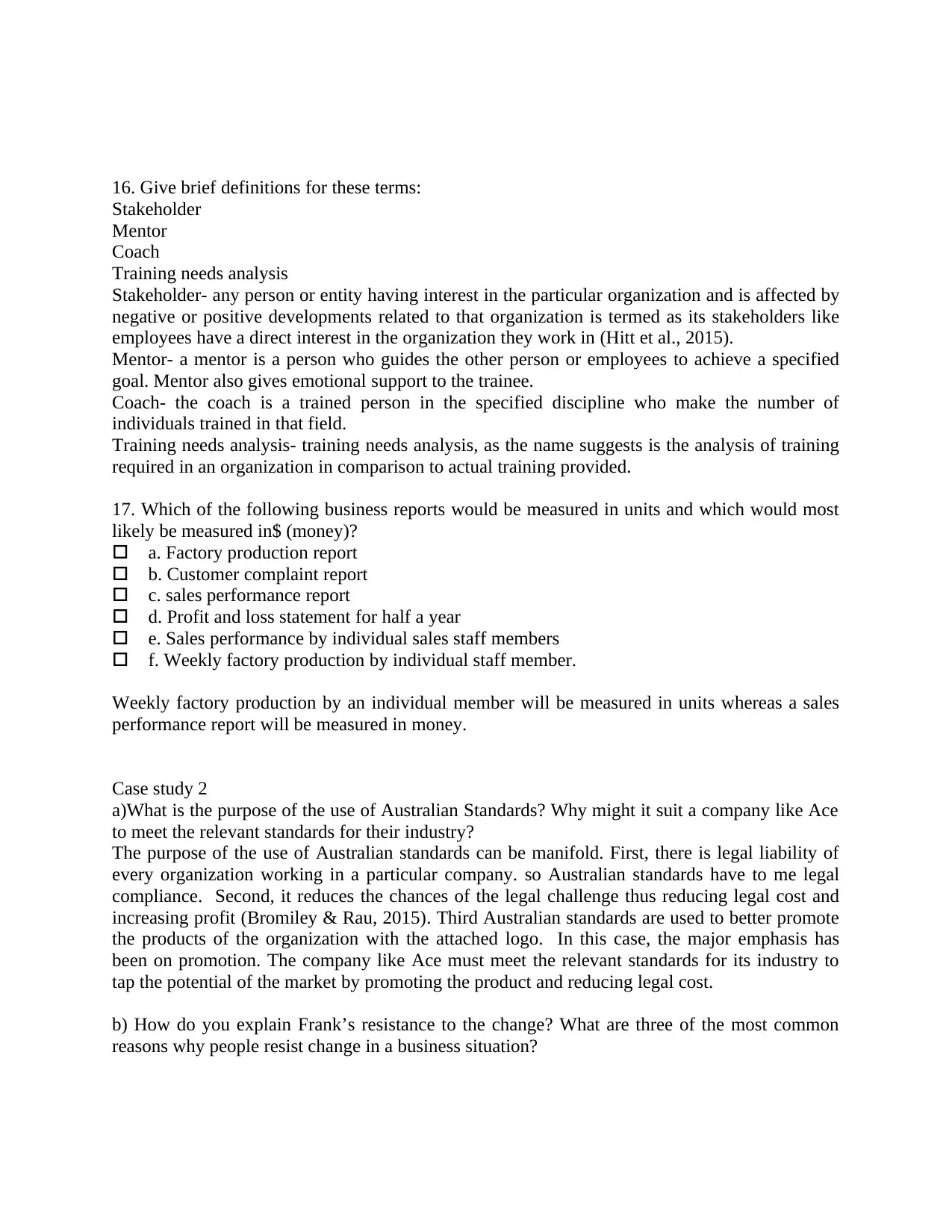
16. Give brief definitions for these terms:
Stakeholder
Mentor
Coach
Training needs analysis
Stakeholder- any person or entity having interest in the particular organization and is affected by
negative or positive developments related to that organization is termed as its stakeholders like
employees have a direct interest in the organization they work in (Hitt et al., 2015).
Mentor- a mentor is a person who guides the other person or employees to achieve a specified
goal. Mentor also gives emotional support to the trainee.
Coach- the coach is a trained person in the specified discipline who make the number of
individuals trained in that field.
Training needs analysis- training needs analysis, as the name suggests is the analysis of training
required in an organization in comparison to actual training provided.
17. Which of the following business reports would be measured in units and which would most
likely be measured in$ (money)?
a. Factory production report
b. Customer complaint report
c. sales performance report
d. Profit and loss statement for half a year
e. Sales performance by individual sales staff members
f. Weekly factory production by individual staff member.
Weekly factory production by an individual member will be measured in units whereas a sales
performance report will be measured in money.
Case study 2
a)What is the purpose of the use of Australian Standards? Why might it suit a company like Ace
to meet the relevant standards for their industry?
The purpose of the use of Australian standards can be manifold. First, there is legal liability of
every organization working in a particular company. so Australian standards have to me legal
compliance. Second, it reduces the chances of the legal challenge thus reducing legal cost and
increasing profit (Bromiley & Rau, 2015). Third Australian standards are used to better promote
the products of the organization with the attached logo. In this case, the major emphasis has
been on promotion. The company like Ace must meet the relevant standards for its industry to
tap the potential of the market by promoting the product and reducing legal cost.
b) How do you explain Frank’s resistance to the change? What are three of the most common
reasons why people resist change in a business situation?
Stakeholder
Mentor
Coach
Training needs analysis
Stakeholder- any person or entity having interest in the particular organization and is affected by
negative or positive developments related to that organization is termed as its stakeholders like
employees have a direct interest in the organization they work in (Hitt et al., 2015).
Mentor- a mentor is a person who guides the other person or employees to achieve a specified
goal. Mentor also gives emotional support to the trainee.
Coach- the coach is a trained person in the specified discipline who make the number of
individuals trained in that field.
Training needs analysis- training needs analysis, as the name suggests is the analysis of training
required in an organization in comparison to actual training provided.
17. Which of the following business reports would be measured in units and which would most
likely be measured in$ (money)?
a. Factory production report
b. Customer complaint report
c. sales performance report
d. Profit and loss statement for half a year
e. Sales performance by individual sales staff members
f. Weekly factory production by individual staff member.
Weekly factory production by an individual member will be measured in units whereas a sales
performance report will be measured in money.
Case study 2
a)What is the purpose of the use of Australian Standards? Why might it suit a company like Ace
to meet the relevant standards for their industry?
The purpose of the use of Australian standards can be manifold. First, there is legal liability of
every organization working in a particular company. so Australian standards have to me legal
compliance. Second, it reduces the chances of the legal challenge thus reducing legal cost and
increasing profit (Bromiley & Rau, 2015). Third Australian standards are used to better promote
the products of the organization with the attached logo. In this case, the major emphasis has
been on promotion. The company like Ace must meet the relevant standards for its industry to
tap the potential of the market by promoting the product and reducing legal cost.
b) How do you explain Frank’s resistance to the change? What are three of the most common
reasons why people resist change in a business situation?
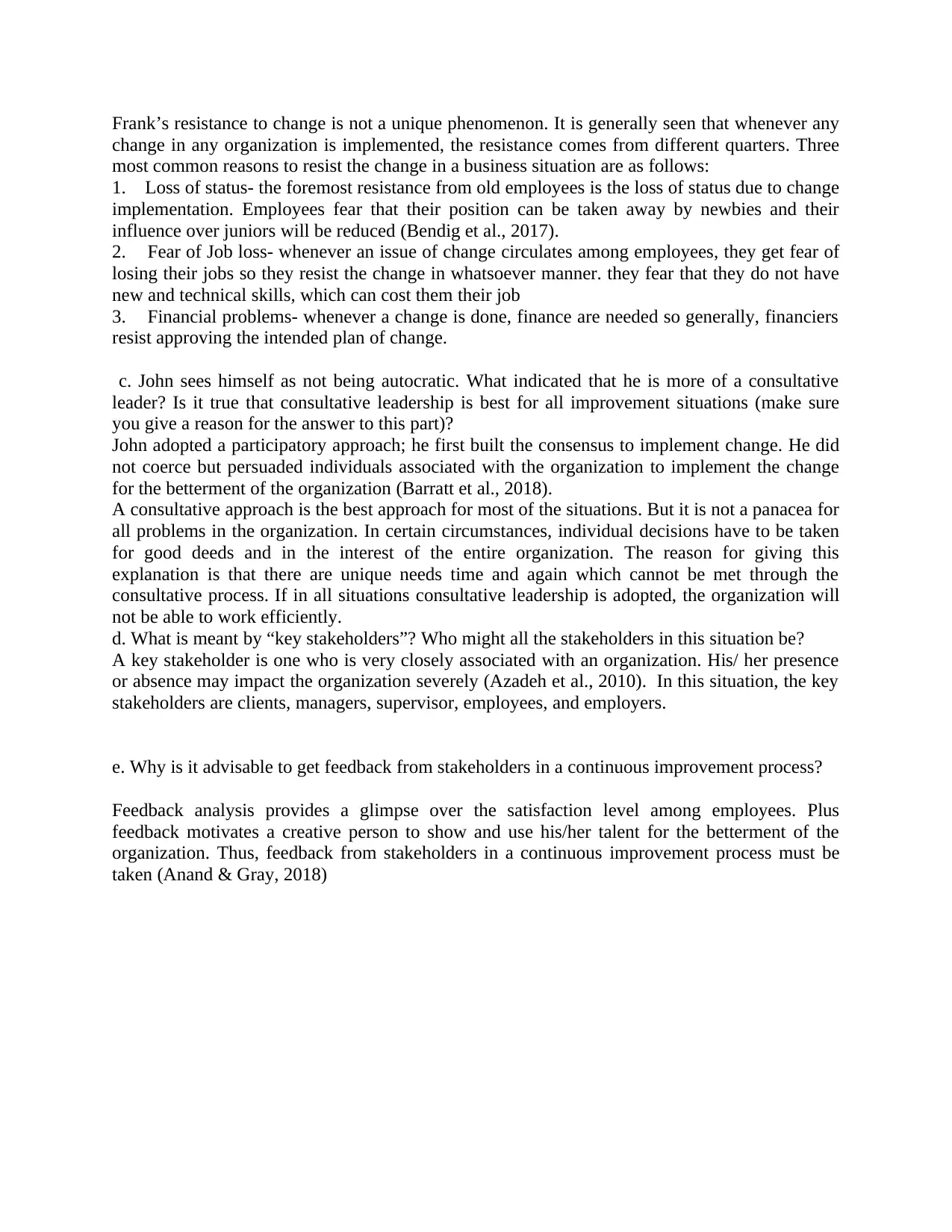
Frank’s resistance to change is not a unique phenomenon. It is generally seen that whenever any
change in any organization is implemented, the resistance comes from different quarters. Three
most common reasons to resist the change in a business situation are as follows:
1. Loss of status- the foremost resistance from old employees is the loss of status due to change
implementation. Employees fear that their position can be taken away by newbies and their
influence over juniors will be reduced (Bendig et al., 2017).
2. Fear of Job loss- whenever an issue of change circulates among employees, they get fear of
losing their jobs so they resist the change in whatsoever manner. they fear that they do not have
new and technical skills, which can cost them their job
3. Financial problems- whenever a change is done, finance are needed so generally, financiers
resist approving the intended plan of change.
c. John sees himself as not being autocratic. What indicated that he is more of a consultative
leader? Is it true that consultative leadership is best for all improvement situations (make sure
you give a reason for the answer to this part)?
John adopted a participatory approach; he first built the consensus to implement change. He did
not coerce but persuaded individuals associated with the organization to implement the change
for the betterment of the organization (Barratt et al., 2018).
A consultative approach is the best approach for most of the situations. But it is not a panacea for
all problems in the organization. In certain circumstances, individual decisions have to be taken
for good deeds and in the interest of the entire organization. The reason for giving this
explanation is that there are unique needs time and again which cannot be met through the
consultative process. If in all situations consultative leadership is adopted, the organization will
not be able to work efficiently.
d. What is meant by “key stakeholders”? Who might all the stakeholders in this situation be?
A key stakeholder is one who is very closely associated with an organization. His/ her presence
or absence may impact the organization severely (Azadeh et al., 2010). In this situation, the key
stakeholders are clients, managers, supervisor, employees, and employers.
e. Why is it advisable to get feedback from stakeholders in a continuous improvement process?
Feedback analysis provides a glimpse over the satisfaction level among employees. Plus
feedback motivates a creative person to show and use his/her talent for the betterment of the
organization. Thus, feedback from stakeholders in a continuous improvement process must be
taken (Anand & Gray, 2018)
change in any organization is implemented, the resistance comes from different quarters. Three
most common reasons to resist the change in a business situation are as follows:
1. Loss of status- the foremost resistance from old employees is the loss of status due to change
implementation. Employees fear that their position can be taken away by newbies and their
influence over juniors will be reduced (Bendig et al., 2017).
2. Fear of Job loss- whenever an issue of change circulates among employees, they get fear of
losing their jobs so they resist the change in whatsoever manner. they fear that they do not have
new and technical skills, which can cost them their job
3. Financial problems- whenever a change is done, finance are needed so generally, financiers
resist approving the intended plan of change.
c. John sees himself as not being autocratic. What indicated that he is more of a consultative
leader? Is it true that consultative leadership is best for all improvement situations (make sure
you give a reason for the answer to this part)?
John adopted a participatory approach; he first built the consensus to implement change. He did
not coerce but persuaded individuals associated with the organization to implement the change
for the betterment of the organization (Barratt et al., 2018).
A consultative approach is the best approach for most of the situations. But it is not a panacea for
all problems in the organization. In certain circumstances, individual decisions have to be taken
for good deeds and in the interest of the entire organization. The reason for giving this
explanation is that there are unique needs time and again which cannot be met through the
consultative process. If in all situations consultative leadership is adopted, the organization will
not be able to work efficiently.
d. What is meant by “key stakeholders”? Who might all the stakeholders in this situation be?
A key stakeholder is one who is very closely associated with an organization. His/ her presence
or absence may impact the organization severely (Azadeh et al., 2010). In this situation, the key
stakeholders are clients, managers, supervisor, employees, and employers.
e. Why is it advisable to get feedback from stakeholders in a continuous improvement process?
Feedback analysis provides a glimpse over the satisfaction level among employees. Plus
feedback motivates a creative person to show and use his/her talent for the betterment of the
organization. Thus, feedback from stakeholders in a continuous improvement process must be
taken (Anand & Gray, 2018)
⊘ This is a preview!⊘
Do you want full access?
Subscribe today to unlock all pages.

Trusted by 1+ million students worldwide
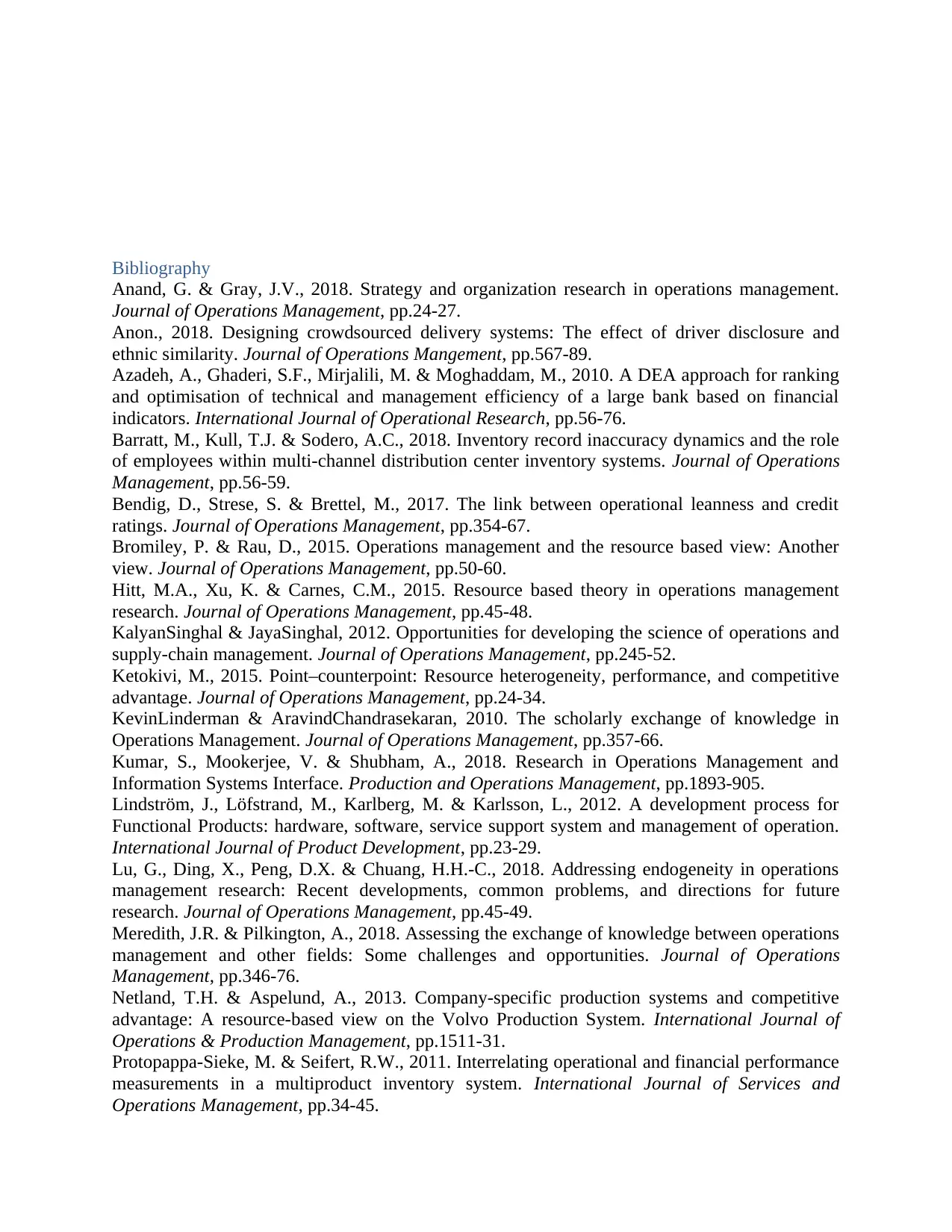
Bibliography
Anand, G. & Gray, J.V., 2018. Strategy and organization research in operations management.
Journal of Operations Management, pp.24-27.
Anon., 2018. Designing crowdsourced delivery systems: The effect of driver disclosure and
ethnic similarity. Journal of Operations Mangement, pp.567-89.
Azadeh, A., Ghaderi, S.F., Mirjalili, M. & Moghaddam, M., 2010. A DEA approach for ranking
and optimisation of technical and management efficiency of a large bank based on financial
indicators. International Journal of Operational Research, pp.56-76.
Barratt, M., Kull, T.J. & Sodero, A.C., 2018. Inventory record inaccuracy dynamics and the role
of employees within multi-channel distribution center inventory systems. Journal of Operations
Management, pp.56-59.
Bendig, D., Strese, S. & Brettel, M., 2017. The link between operational leanness and credit
ratings. Journal of Operations Management, pp.354-67.
Bromiley, P. & Rau, D., 2015. Operations management and the resource based view: Another
view. Journal of Operations Management, pp.50-60.
Hitt, M.A., Xu, K. & Carnes, C.M., 2015. Resource based theory in operations management
research. Journal of Operations Management, pp.45-48.
KalyanSinghal & JayaSinghal, 2012. Opportunities for developing the science of operations and
supply-chain management. Journal of Operations Management, pp.245-52.
Ketokivi, M., 2015. Point–counterpoint: Resource heterogeneity, performance, and competitive
advantage. Journal of Operations Management, pp.24-34.
KevinLinderman & AravindChandrasekaran, 2010. The scholarly exchange of knowledge in
Operations Management. Journal of Operations Management, pp.357-66.
Kumar, S., Mookerjee, V. & Shubham, A., 2018. Research in Operations Management and
Information Systems Interface. Production and Operations Management, pp.1893-905.
Lindström, J., Löfstrand, M., Karlberg, M. & Karlsson, L., 2012. A development process for
Functional Products: hardware, software, service support system and management of operation.
International Journal of Product Development, pp.23-29.
Lu, G., Ding, X., Peng, D.X. & Chuang, H.H.-C., 2018. Addressing endogeneity in operations
management research: Recent developments, common problems, and directions for future
research. Journal of Operations Management, pp.45-49.
Meredith, J.R. & Pilkington, A., 2018. Assessing the exchange of knowledge between operations
management and other fields: Some challenges and opportunities. Journal of Operations
Management, pp.346-76.
Netland, T.H. & Aspelund, A., 2013. Company-specific production systems and competitive
advantage: A resource-based view on the Volvo Production System. International Journal of
Operations & Production Management, pp.1511-31.
Protopappa-Sieke, M. & Seifert, R.W., 2011. Interrelating operational and financial performance
measurements in a multiproduct inventory system. International Journal of Services and
Operations Management, pp.34-45.
Anand, G. & Gray, J.V., 2018. Strategy and organization research in operations management.
Journal of Operations Management, pp.24-27.
Anon., 2018. Designing crowdsourced delivery systems: The effect of driver disclosure and
ethnic similarity. Journal of Operations Mangement, pp.567-89.
Azadeh, A., Ghaderi, S.F., Mirjalili, M. & Moghaddam, M., 2010. A DEA approach for ranking
and optimisation of technical and management efficiency of a large bank based on financial
indicators. International Journal of Operational Research, pp.56-76.
Barratt, M., Kull, T.J. & Sodero, A.C., 2018. Inventory record inaccuracy dynamics and the role
of employees within multi-channel distribution center inventory systems. Journal of Operations
Management, pp.56-59.
Bendig, D., Strese, S. & Brettel, M., 2017. The link between operational leanness and credit
ratings. Journal of Operations Management, pp.354-67.
Bromiley, P. & Rau, D., 2015. Operations management and the resource based view: Another
view. Journal of Operations Management, pp.50-60.
Hitt, M.A., Xu, K. & Carnes, C.M., 2015. Resource based theory in operations management
research. Journal of Operations Management, pp.45-48.
KalyanSinghal & JayaSinghal, 2012. Opportunities for developing the science of operations and
supply-chain management. Journal of Operations Management, pp.245-52.
Ketokivi, M., 2015. Point–counterpoint: Resource heterogeneity, performance, and competitive
advantage. Journal of Operations Management, pp.24-34.
KevinLinderman & AravindChandrasekaran, 2010. The scholarly exchange of knowledge in
Operations Management. Journal of Operations Management, pp.357-66.
Kumar, S., Mookerjee, V. & Shubham, A., 2018. Research in Operations Management and
Information Systems Interface. Production and Operations Management, pp.1893-905.
Lindström, J., Löfstrand, M., Karlberg, M. & Karlsson, L., 2012. A development process for
Functional Products: hardware, software, service support system and management of operation.
International Journal of Product Development, pp.23-29.
Lu, G., Ding, X., Peng, D.X. & Chuang, H.H.-C., 2018. Addressing endogeneity in operations
management research: Recent developments, common problems, and directions for future
research. Journal of Operations Management, pp.45-49.
Meredith, J.R. & Pilkington, A., 2018. Assessing the exchange of knowledge between operations
management and other fields: Some challenges and opportunities. Journal of Operations
Management, pp.346-76.
Netland, T.H. & Aspelund, A., 2013. Company-specific production systems and competitive
advantage: A resource-based view on the Volvo Production System. International Journal of
Operations & Production Management, pp.1511-31.
Protopappa-Sieke, M. & Seifert, R.W., 2011. Interrelating operational and financial performance
measurements in a multiproduct inventory system. International Journal of Services and
Operations Management, pp.34-45.
Paraphrase This Document
Need a fresh take? Get an instant paraphrase of this document with our AI Paraphraser
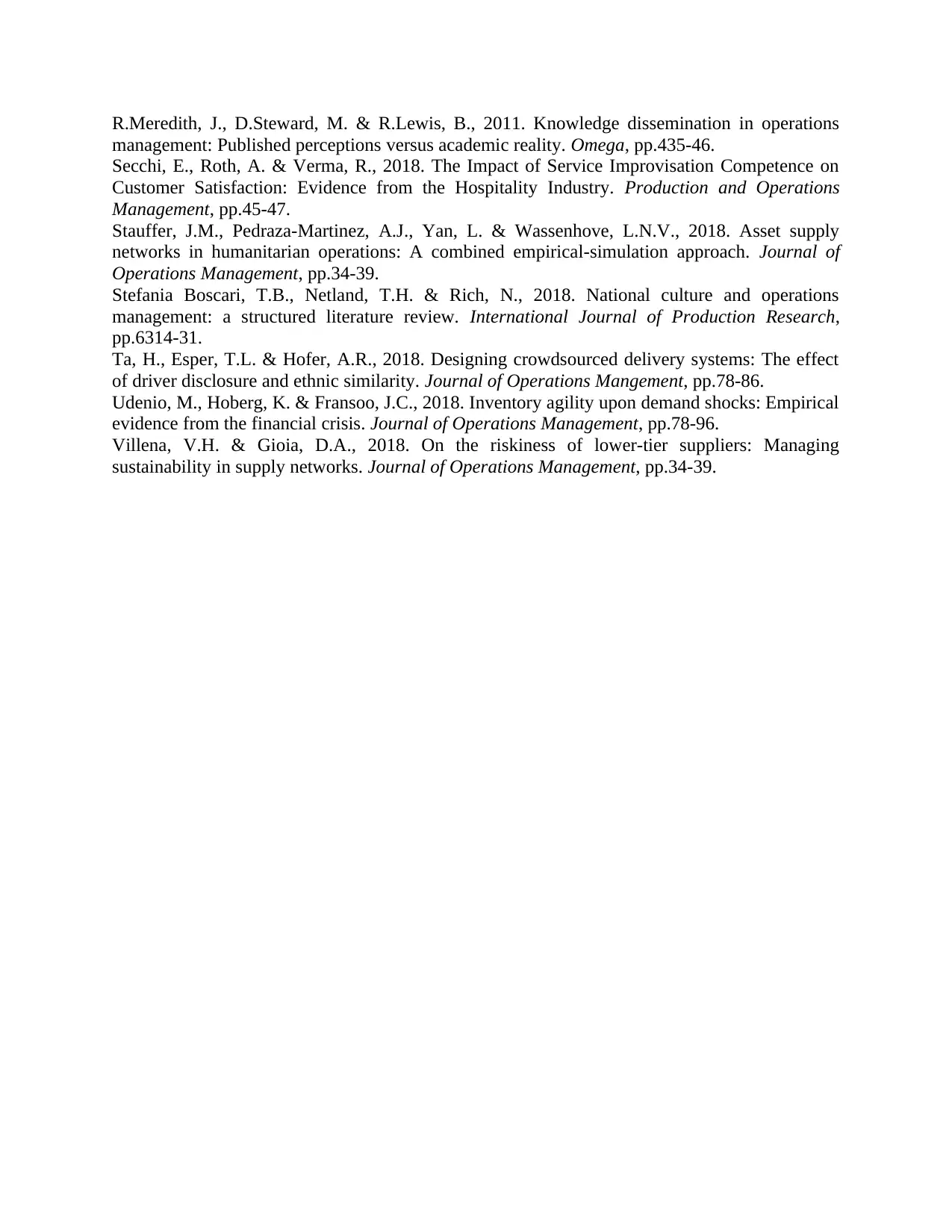
R.Meredith, J., D.Steward, M. & R.Lewis, B., 2011. Knowledge dissemination in operations
management: Published perceptions versus academic reality. Omega, pp.435-46.
Secchi, E., Roth, A. & Verma, R., 2018. The Impact of Service Improvisation Competence on
Customer Satisfaction: Evidence from the Hospitality Industry. Production and Operations
Management, pp.45-47.
Stauffer, J.M., Pedraza-Martinez, A.J., Yan, L. & Wassenhove, L.N.V., 2018. Asset supply
networks in humanitarian operations: A combined empirical-simulation approach. Journal of
Operations Management, pp.34-39.
Stefania Boscari, T.B., Netland, T.H. & Rich, N., 2018. National culture and operations
management: a structured literature review. International Journal of Production Research,
pp.6314-31.
Ta, H., Esper, T.L. & Hofer, A.R., 2018. Designing crowdsourced delivery systems: The effect
of driver disclosure and ethnic similarity. Journal of Operations Mangement, pp.78-86.
Udenio, M., Hoberg, K. & Fransoo, J.C., 2018. Inventory agility upon demand shocks: Empirical
evidence from the financial crisis. Journal of Operations Management, pp.78-96.
Villena, V.H. & Gioia, D.A., 2018. On the riskiness of lower-tier suppliers: Managing
sustainability in supply networks. Journal of Operations Management, pp.34-39.
management: Published perceptions versus academic reality. Omega, pp.435-46.
Secchi, E., Roth, A. & Verma, R., 2018. The Impact of Service Improvisation Competence on
Customer Satisfaction: Evidence from the Hospitality Industry. Production and Operations
Management, pp.45-47.
Stauffer, J.M., Pedraza-Martinez, A.J., Yan, L. & Wassenhove, L.N.V., 2018. Asset supply
networks in humanitarian operations: A combined empirical-simulation approach. Journal of
Operations Management, pp.34-39.
Stefania Boscari, T.B., Netland, T.H. & Rich, N., 2018. National culture and operations
management: a structured literature review. International Journal of Production Research,
pp.6314-31.
Ta, H., Esper, T.L. & Hofer, A.R., 2018. Designing crowdsourced delivery systems: The effect
of driver disclosure and ethnic similarity. Journal of Operations Mangement, pp.78-86.
Udenio, M., Hoberg, K. & Fransoo, J.C., 2018. Inventory agility upon demand shocks: Empirical
evidence from the financial crisis. Journal of Operations Management, pp.78-96.
Villena, V.H. & Gioia, D.A., 2018. On the riskiness of lower-tier suppliers: Managing
sustainability in supply networks. Journal of Operations Management, pp.34-39.
1 out of 11
Related Documents
Your All-in-One AI-Powered Toolkit for Academic Success.
+13062052269
info@desklib.com
Available 24*7 on WhatsApp / Email
![[object Object]](/_next/static/media/star-bottom.7253800d.svg)
Unlock your academic potential
Copyright © 2020–2025 A2Z Services. All Rights Reserved. Developed and managed by ZUCOL.


